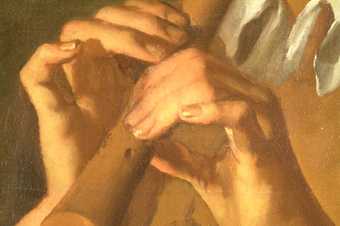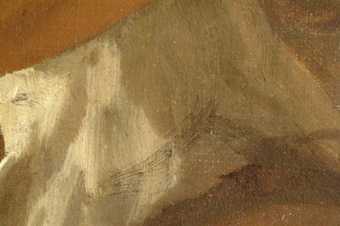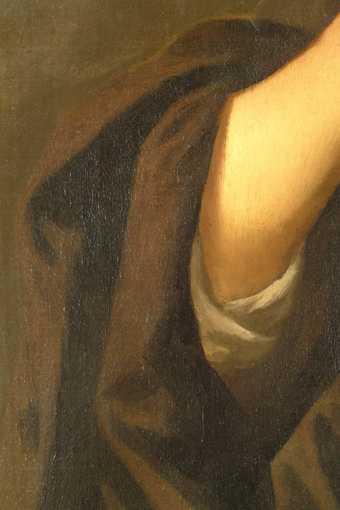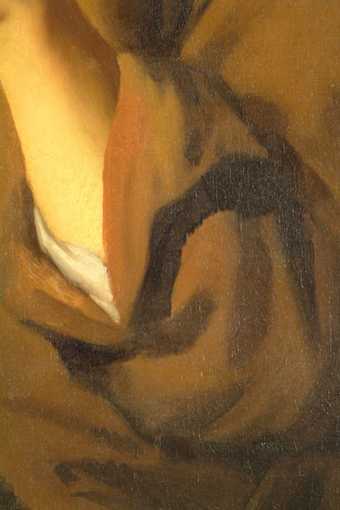
Sir Peter Lely 1618–1680
Man Playing a Pipe
c.1648
Oil paint on canvas
1428 x 1055 mm
T00885
This painting is in oil paint on canvas measuring 1428 x 1055 mm (fig.1). The support is a single piece of plain woven, linen canvas (fig.2). It has an open weave with 12.5 threads per square cm in both directions. There are numerous weave faults and thickenings in the threads. There is strong cusping of the canvas weave on all sides but the original tacking margins are not present.1 In almost every respect this support looks the same as the pendant to this painting, Boy Playing a Jew’s Harp (Tate T00884).2 Although the present stretcher looks contemporary with the glue composition lining, which appears to date from the late nineteenth or early twentieth century, by chance we have a good idea of the appearance of an earlier stretcher – probably the original. The X-radiograph shows the ghost of a narrow-barred stretcher or strainer with a horizontal cross-piece and diagonal braces at the corners. A coat of paint must have been applied to the back of the painting after it had been attached to this stretcher, the brush able to reach behind most of the horizontal cross-piece but not under the outer bars or the diagonal braces. This feature is present also in the pendant painting.
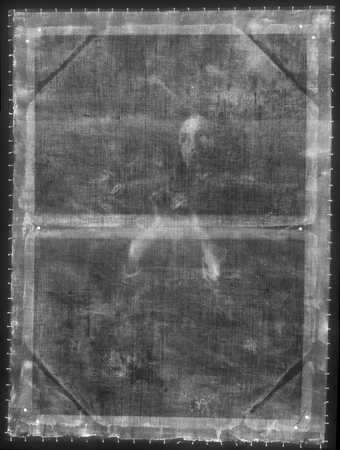
Fig.2
X-radiograph of Man Playing a Pipe c.1648
The ground is a thin coat of buff coloured paint (figs.3–4). During application it was pressed deep into the canvas weave and is on average 40 microns thick. Viewed in cross-section it appears as a semi-translucent, yellowish white layer. Analysis of the ground from the pendant painting revealed marine chalk, lead white and black.3 Tests with acid fuchsin proved negative, indicating that its binding medium must be oil, since it is not proteinaceous.

Fig.3
Cross-section through the brownish grey background at the right edge, photographed at x320 magnification. From the bottom: sliver of the ground on the lower right of the sample; greyish beige priming; dark, opaque paint of the background; accumulated layers of varnis
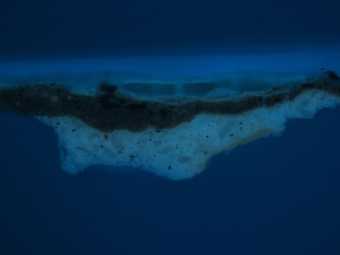
Fig.4
Cross-section through the brownish grey background at the right edge, photographed at x320 magnification in ultraviolet light. From the bottom: sliver of the ground on the lower right of the sample; greyish beige priming; dark, opaque paint of the background; accumulated layers of varnish
The priming is opaque greyish beige colour, composed of lead white, chalk, Cologne earth, black and glassy particles, mixed together and bound in oil. It has a smooth surface but at about 65 microns thickness, is thin enough to allow the texture of the weave to modulate it. Both these layers are present in the pendant painting.
Like most pictures by Lely in this study, this painting reveals no underdrawing with any method of examination (fig.5). Using other, later works by Lely as evidence, it is probable that the image was laid in roughly with brown paint, which was often left to stand as the shadows of the figure in the finished painting, perhaps strengthened here and there with similarly coloured paint. The shadows of the flesh tones in this painting are mid-brown, so perhaps this was the colour used for the first lay-in.
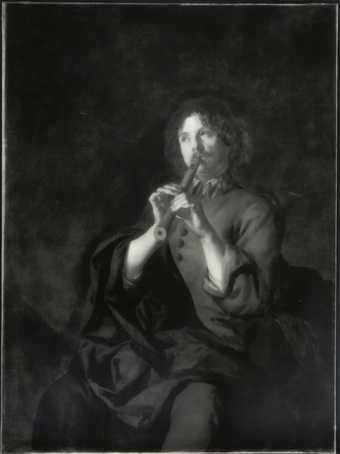
Fig.5
Infrared reflectograph of Man Playing a Pipe
In the finished picture we see an overall thin application of opaque paint, using coarsely bristled brushes that create clearly visible strokes on the surface (figs.6–11). Wide brushes loosely and rapidly filled in the large expanses of brownish grey background, the scumbling technique creating different thickness of paint. Narrower, sweeping brushstrokes define the clothing in a few distinct, premixed tones from highlight to shadow with little intermingling of paint. There are areas of minor impasto in the flesh created by the zig-zag strokes of still finer brushes. The brownish grey background paint is composed of mixtures of black, Cologne earth, lead white, yellow ochre and glassy particles. The darkest shadows of the cloak were mixed similarly, though with the addition of umber, and with the glassy particles replaced with another type of translucent filler.4
Some pentimenti are visible, most notably two curls of black hair on the forehead (fig.12). Early cleaning has left some of the dark areas looking worn (fig.13).
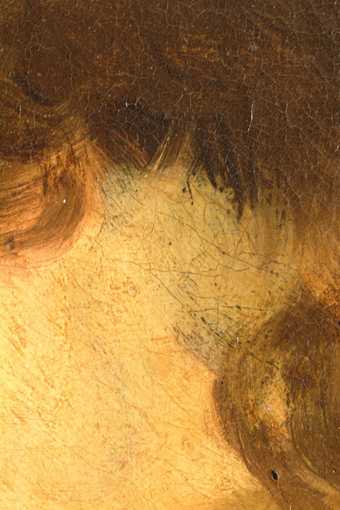
Fig.12
Detail showing the pentimento in the forehead
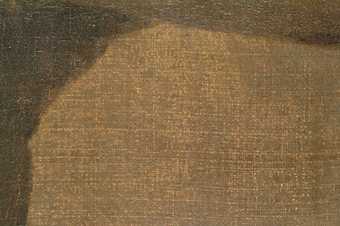
Fig.13
Old abrasion of the thin dark paint of the background
July 2003



